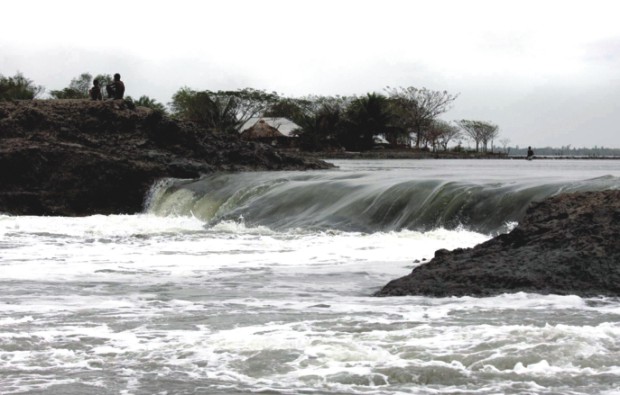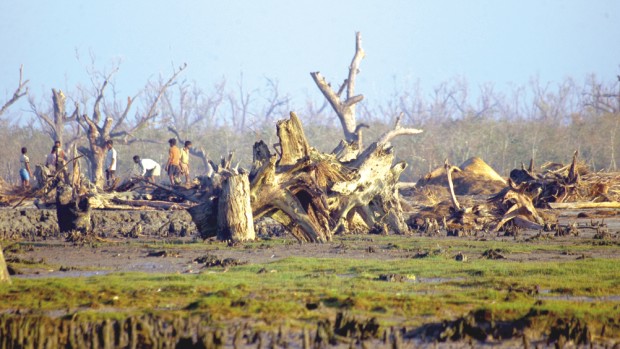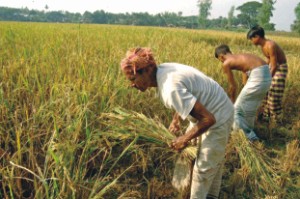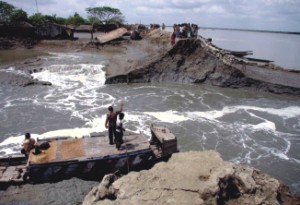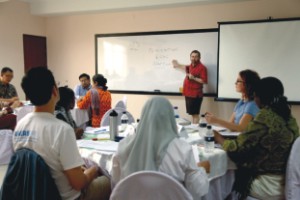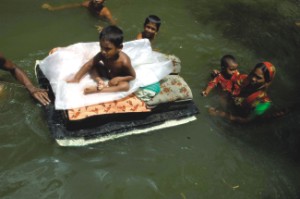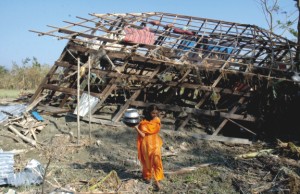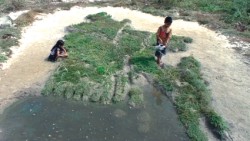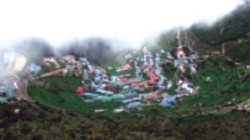| Home - Back Issues - The Team - Contact Us |
 |
| Volume 10 |Issue 14 | April 08, 2011 | |
|
|
Cover Story The Importance of Adaptation Climate change is a broad and somewhat vague term used by scientists to explain the effects of emissions of carbon dioxide and various gases into the atmosphere. Atmospheric scientists, at the beginning of the twentieth century, knew that change was coming, but they didn't understand, what exactly, those changes would be. The gases released, started to trap the sun's heat into the layers of the atmosphere close to the earth's surface, slowly increasing the earth's temperature. Anika Hossain Over the past hundred years, temperatures have gone up by 0.7 degrees Celsius and it has been predicted that by 2050, unless drastic measures are taken, they will go up by two degrees, compared to the beginning of the twentieth century. The more popular term to describe this phenomenon is global warming, but from a scientific point of view, this is not a very appropriate term. Dr Ian Burton, a professor of environmental science at the University of Toronto on a recent visit to Bangladesh, says, "When the media got a hold of the climate change concept, they wanted a more communicating way to talk about it, so they named it global warming. But with climate change, not all parts of the world are facing increasing temperatures. In fact, some places might even get a little colder."
These extremes in weather patterns have the most severe effects on people living in poor, developing countries, such as Bangladesh, Myanmar, many places in Africa and Asia, who have the least amount of resources and finances to protect themselves and their livelihoods against this phenomenon. Imagine the life of a farmer in Bangladesh. His entire existence depends on the crops he produces. His rain-fed agriculture depends heavily on the weather, the soil quality, irrigation etc. Crop failures and livestock death can mean poverty and eventually starvation for his family. On top of that, he has to worry about floods, tropical cyclones, tornados and mudslides threatening his life, his home and his land. A farmer in Africa has to worry about the pattern of droughts, and how to survive in the event of a long drawn out dry period. These natural disasters, brought on by human contribution to the changes in the climatic condition affect urban areas and industries as well. While steps for mitigation are being taken worldwide, these poor countries must think of ways to adapt, use the resources available to them to tackle climate change. Reduction in the burning of fossil fuel, coal, oil and natural gas as well as deforestation will eventually slow down the effects of climate change, but for now, people have to learn how to live with it and survive. Farmers have to manage their lands better, rehabilitate degraded crop and pasture land and practice better farming techniques more suited to the changing weather. Communities must come up with strategies for disaster risk management, such as cyclone, hurricane or tornado alerts and shelters in both urban and rural areas. Infrastructure must be built to withstand natural disasters. Governments have to come up with strategies to protect their people, industries, gas, water and electricity supplies. Even countries with limited finances can take many precautions.
Bangladesh is one of the poorer countries, which has been proactive about adaptation to climate change. From their storm alerts, shelters, to agriculture, local people have used age-old methods and materials to acclimatise. In the southwest region, farmers are experimenting with salt tolerant rice, to adapt to the increasing saline waters. In other parts of the country where water levels are rising, people are experimenting with floating gardens. These innovative ways are coming from the locals. Although they have limited education and training if any, they know changes are happening and they must do what they can to survive. Likewise, the NGO's and government organisations are taking an active interest in adaptation. These initiatives captured the attention of an international organisation known as the International Centre for Climate Change and Development (ICCCAD), a joint venture between three established institutions, The Independent University, Bangladesh, the Bangladesh Centre for Advanced Studies (BCAS) and the International Institute for Environment and Development (IIED) based in London. ICCAD aims to build capacity in developing and least developing countries, to adapt to and tackle problems related to climate change.
This institution took a special interest in Bangladesh for all it has to offer. The director of this institute, the first of its kind in Bangladesh, Dr Saleemul Haque says, "There is a lot happening in Bangladesh, and we want people from other parts of the world to know and learn from them." According to Dr Haque who is a senior Fellow, Climate Change Group, iied, ICCCAD will base itself in IUB and collaborate with its School of Environmental Science to run a series of short courses on various aspects of climate change in relation to development. These courses will be designed for young professionals from various fields of work, in government institutions, NGOs, the academic arena, media and many more. Each course will be tailor made for professionals from these fields and will focus on the role these individuals can play in their own field of work to deal with climate change. "We have had five short courses already and will be starting the sixth," says Haque. "These courses are seven day long, intensive courses with cohorts of participants from different countries. For the next course, we have twenty-two participants of whom seventeen are international, mostly from Asia and Africa, the rest are Bangladeshi. We have a number of international research persons coming to teach this course,” he continues. "So far, we have had two courses on community based adaptation, one on disaster risk management, one on research on climate change and one for academics who are interested to teach climate change in their universities," says Haque. "These courses were taught in Africa for professionals from the Eastern and Southern parts of the continent. Not all the courses will be run in Dhaka," shares Haque.
The ICCCAD has also designed a Masters degree course, which has been submitted to the national authorities for approval. This course will be offered next year. "One of our goals is to network and support other universities in Asia, Africa and other developing countries," says Haque. "Our participants come from various different sectors and they did not need to know about climate change in the past, but now, everyone needs to know something. They need to acquire this knowledge and apply it to their work in some way. Since not everyone has time to complete their Masters, our short courses tell them the important things they need to know." Dr Ian Burton, co-chair of ICCCAD, says, "We are hoping that the centre will attract students from all over the developing world and from developed countries as well. The hope is to develop partnerships with universities all over the world. For my university, the University of Toronto, we are looking to connect ourselves with ICCCAD so our graduate students can do research here in Bangladesh and ICCCAD students can come to Toronto." "It is very important for young professionals to know what is coming in terms of climate change," continues Burton. "Climate change has happened and will continue to happen but that doesn't mean we know how it will happen or how fast it will happen. There is uncertainty about how much it will change and in what ways. So it is important to study the facts about its science and impact. It is very varied from place to place. For example, if you're someone who is managing water resources, for irrigation or other purposes, there are many areas in the world that suffer periodically from drought. But in countries in like Australia, North America, many parts of Africa, Europe and Russia, there are places experiencing unexpected droughts. If you are managing water supply there, you have to know what to do to adapt to these changes." "While traditional techniques and technology like those used here in Bangladesh are important, they can be improved," says Burton, "Better materials can be used to do things the old way. That calls for international cooperation and educating people on what's available and facilitating the use of this technology on local, national and international levels, and that is what we are trying to do. We want people to come to Bangladesh or wherever initiatives are being taken to tackle climate change, see what they do and try to copy it," he concludes.
Terry Cannon, the Director of Studies believes establishing ICCCAD in Bangladesh was a good idea in many ways. "A lot of training and education about climate change is happening in western countries which will not be as affected by it as the poorer countries like Bangladesh, most of Africa and much of Asia, so the idea of setting up this centre in Bangladesh is to bring people from different places here to experience adaptation at the front line where it will affect people in serious ways." Whether its people spontaneously responding to the changes in how they farm, or how institutions have been built, like the Bangladesh Climate Change Strategy Action Plan, the first in the world, there are positive things happening from the top levels of the government to the grass roots level to deal with climate change. "We can show our participants these things during the field visits which are a part of the short courses. There aren't many international programmes operating in developing countries in relation to climate change and development. It is important that the work begins in these countries facing maximum impact," says Cannon. "In our courses, we do not teach adaptation techniques," says Cannon, "Rather we ask people, what you can do within your field of work to tackle climate change. We ask them this question before they start the course and they have to come up with a work plan. We give them the information they need and tell them where to look for answers. They won't become experts overnight, or even in a week so we give them the information they need so they'll know something of what needs to be done." According to Cannon, the institute does not do any research itself, but it facilitates research on climate change. "Farmers are the main researchers," he says. "They have been for hundreds of years. Farmers discovered agriculture and that's why we have food. They may not know what climate change is, but they are adapting." As for Bangladesh, universities and NGOs are doing intensive research work The Bangladesh Rice Research Institute (BIRI) and Bangladesh Agricultural Research Institute (BARI) are also collaborating to do research on rice cultivation and other crops. The Food and Agricultural Organisation (FAO) are also doing research on climate change and its effects.
"The government of Bangladesh now needs to be prepared for more and longer floods," Cannon says. "They need to be prepared to protect livelihoods, so say if a storm damages the ability of the textile and garments industries they need a plan to overcome that. They need to ask questions like: how do we guard ourselves against the breakdown of the systems to keep livelihoods going? How do we protect our resources under these conditions?" "The government needs to think of community based adaptation and how to facilitate it. How to make contacts and raise funds for disaster risk management," says Burton. "Bangladeshis can receive training and education in different fields and eventually move away from agriculture so the economy is not so heavily dependent upon it. They can invest in other industries to sustain their economy. Climate change may occur faster than you think." ICCAD's goal is to raise awareness and help people prepare for the inevitable. It has now become absolutely necessary to stop ignoring the impact of climate change and decide how we will live with these increasing temperatures. We must submit to the fact that agriculture, fisheries, forests etc will be fundamentally altered, especially where poor people in this world reside. Not all changes may be damaging or negative, crops may improve in some parts of the world due to warmer temperature, but in other, developing parts the main impact will undoubtedly be negative. Knowledge and preparation is the key to survival. It is absolutely vital to adapt. The Deep Impact AANTAKI RAISA Climate change and its devastating impact- global warming- has its share of skeptics who think that it is an exaggerated, over-hyped phenomenon, but climate experts are almost unanimous about the gravity of the consequences of global warming. Much has been said about the culprits of this human-made (or is it?) phenomenon; extensive research programmes have been going around for years to predict the impacts of climate change, treaties have been signed, conventions have been enforced, voluntary and compulsory mitigation commitments have been made; but the ugly truth is, even if the emission of Green House Gases (GHGs) is reduced to zero percent, climate change is inevitable. Not all parts of the earth are going to be affected uniformly; four specific regions- the two poles, the African continent, the islands and the mega deltas- are going to be the worst victims of climate change. The first thing to do here is to learn to adapt to the yet now unknown consequences of climate change. Bangladesh, being one of the mega deltas of the world, is already listed as the number one victim of this human-made 'disaster'; and being a nation of resilience and survival, our traditional sciences and technologies have evolved to counter the effects of climate change. Still, there is a lot more to learn about the physical science behind this major event of the Anthropocene Age and how we can adapt to the changes we are going to face in order to sustain a better economy, livelihood and most of all our very existence.
“Change is the only constant in life” and it is not true only for human lives; from microcosm to macrocosms, from amoeba to the whole universe have gone through the inexorable process of change. The planet Earth has faced her own share of changes. Like everything else, climate has also changed since the beginning of its existence. If climate change is a natural phenomenon, then why so much ado about today's changing climate? Climate change has been termed as 'global warming' for a better effect on the masses and we all have been taught rigorously about the Green House effect, increasing temperature, rising sea level and the culprits--industrialisation, deforestation, urbanisation and massive emission of GHGs- primarily carbon dioxide, methane, nitrous oxide and halocarbons (gases once used widely as refrigerants and spray propellants). But, global temperature hasn't yet increased enough to sweat people to death, neither has it raised the sea levels 'adequately' to inundate the islands and the coastal areas of low lying countries permanently. Well, experts are concerned because, climate change is a lengthy process and its impacts manifest slowly. Still, the question is how the scientists are so sure that climate change of the 21st century is triggered by human-made causes and is not a natural phenomenon? This is an important question to be answered because, as the causes are the offspring of the developed countries who are skeptic about the claims of this new form of disaster, they need to be pinpointed to the catastrophe we are heading to. Even a few years ago, climate change was a headache only for a limited number of scientists but with the increasing evidence and the number of research works, climate change has become a global concern. “Because the scientific evidence has become stronger and stronger and because people have started to face the effects of climate change, it has become an important issue," says Dr David Dodman, a senior researcher at the International Institute for Environment and Development (IIED), "We can see a long term record of rising temperature over the last 100 years and from the sea level monitoring centres all over the world we see a rising trend in sea level. So we have all these records. We also have increasingly sophisticated models that take into account all the factors that contribute to climate change. These models show a continuing trend of warming as well over the next hundred years." Atmospheric concentrations of the GHGs have increased because of human activities. Such gases trap thermal energy (heat) within the atmosphere by means of the well-known greenhouse effect, leading to global warming. The atmospheric concentrations of carbon dioxide, methane and nitrous oxide remained roughly stable for nearly 10,000 years, before the abrupt and rapidly accelerating increases of the past 200 years. Growth rates for concentrations of carbon dioxide have been faster in the past 10 years than over any 10-year period since continuous atmospheric monitoring began in the 1950s, with concentrations now roughly 35 percent above pre-industrial. Methane levels are roughly two and a half times pre-industrial levels, and nitrous oxide levels are around 20 percent higher. [Source: Fourth Annual Report (AR-4) of the Intergovernmental Panel on Climate Change] How can we be sure that humans are responsible for these increases? Some greenhouse gases (most of the halocarbons, for example) have no natural source. For other gases, two important observations demonstrate human influence. First, the geographic differences in concentrations reveal that sources occur predominantly over land in the more heavily populated Northern Hemisphere. Second, analysis of isotopes, which can distinguish among sources of emissions, demonstrates that the majority of the increase in carbon dioxide comes from combustion of fossil fuels (coal, oil and natural gas). Methane and nitrous oxide increases derive from agricultural practices and the burning of fossil fuels. The pattern of climate change is another indication to the human intervention. The increase of temperature is much greater on land than in the oceans; the increase of temperature is greater on ocean surface than in the deeper layers; this suggests that warming on the land and on the ocean surface has not caused by earth's internal geological activities. Now if we move up in the air, the troposphere (the lower region of the atmosphere) has warmed, the stratosphere, just above it, has cooled. If solar changes provided the dominant forcing, warming would be expected in both atmospheric layers. So, the most probable conclusion is that human activities have triggered this global increase of temperature. Though the phenomenon itself is evident along with its causes, how it might impact our civilisation is still uncertain. The consequences of climate change vary from one place to the other. The way an agro-based economy might be affected by shorter and more intense monsoon and longer droughts, a manufacturing-based economy might not be affected in the same way. Climate change will not just affect a land geologically, i.e. inundate it permanently or turn it into a desert; it will affect the livelihood, the biodiversity, the socio-economic structure, the culture, trend and politics of a region. “The impact of climate change is going to be very, very complicated. Due to the rising sea level, a fifth of the Bangladeshi land will be inundated within the next 50 to 60 years. Roughly 30 to 35 million people are going to be affected by this and they will try to move to high lands for survival. This is not just a national concern but also is a matter of security concern for other countries like Myanmar and India. These people will try to move as migrants to those countries. Myanmar is increasing its border security; India is actually building a fence around Bangladesh to prevent illegal migrations. So, climate change has a multifaceted effect which is very complicated to predict,” says Dr Omar Rahman, one of the founders of the International Centre for Climate Change and Development (ICCCAD) and Vice Chancellor (in charge) of Independent University, Bangladesh. And it is this uncertainty of its impact that makes climate change tricky to tackle and to adapt to. Stories from the Mountain and the Sea Ten young film-makers from Nepal and Bangladesh tell the stories of their TAMANNA KHAN
To a person sitting in a well-lighted, air conditioned room of a high rise in Dhaka, climate change may be something far-fetched; nothing to do with her life. The moment he or she steps outside–right in front of his or her eyes–the old man or the child with a begging bowl, crowding the city like ants, reminds him or her of that very alien issue– climate change. That is what leads Rifat Quamrul Alam, a young civil engineer in Dhaka, to find out more about the topic as he presents his search in his 3.25 minute documentary "Climate Confusion". "Climate Confusion" is one of the ten short-films in the documentary series on climate change, "From the Himalaya to the Bay of Bengal" produced by British Council and Wild Eye, as part of British Council's Climate Change Programme. With a view to educate young people about the climate change and develop ideas for mitigating its effects, British Council has started the International Climate Champions projects all over the world in 2008. In Bangladesh, the project was launched by Ed Miliband, the British minister for energy and climate change in August 2009. As part of the project, 14 young minds from all over Bangladesh were selected through a national competition based on their commitment to address the issue and ideas for project to raise awareness, informs Matthew Knowles, Programme Development Manager of British Council. He says, "Because young people inherit the climate change problem, we have taken up awareness among them through the International Climate Champions project as young people tend to listen to other young people more." Since the audio-visual media reaches people easily by overcoming language and cultural barriers, British Council, in association with Wild Eye, has decided to produce the short-film series "From the Himalaya to the Bay of Bengal" involving champions from Bangladesh and Nepal. "We have specifically chosen this topic to show how the Himalayan ice melts and makes its journey to the Bay of Bengal and the impact on the communities as a result of that," Knowles says.
Wild-life and documentary film-maker Tanjilur Rahman was given the responsibility to groom the 14 champions from Bangladesh and 12 from Nepal to generate ideas for the stories that would encompass different issues of climate change. Due to fund constraints 10 participants were selected for the film-making project – five from Bangladesh and five from Nepal. Selection was based on the participant's ability to make films and the place from which they come. "For example, Tshering Sherpa lives in a remote place in the Himalayas which is difficult to reach for any film-maker and her crew. Only the ordinary Sherpas live there," informs Rahman. Tshering's location obviously made him the right choice to portray the glacier melting that his community faces 13000 feet above the ground. In his 3.40-minute film, "Living in the Cloud" Tshering brings out the ominous fear of glacier bursting, which he and his community live with every day. "Although each of the ten films of the series is linked with one another, each has its own individuality and each can work out as a separate film," says Rahman. His statement is evident throughout the thirty-eight minute of the show that starts with Mushfiq Wahed's "An Omen" and ends with Rojesh Shrestha's "Be Smart–Act First". Interestingly, not all the films are packed with heavy, hard to understand scientific terminology. Some of the films, for instance "An Omen", make the audience laugh at their own ignorance as Mushfiq shows the variety of confused and misinformed answers he got from people of all walks of life regarding the definition of climate change.
Similarly, Sushila Pandith's satirical "Water World" amuses the audience with its puppet fish depicting the politics of climate change. Shushila, an environment science student and a radio news-presenter from Nepal, says, "I was very actively involved in the campaigning and awareness raising activities on climate change in Nepal. I worked with a lot of passion and energy. But when I went to COP15 summit in Copenhagen (UN Conference on Climate Change), I saw that our actions are not portrayed in the right way. There was too much politics going on in COP15. Even the developing countries are involved in that. We are depending on them to give us money and fighting over how much money we can get, without starting our own action. I did not like that. So when I got the opportunity to make the documentary, I picked this subject." Nazla Bushra's mini-Bangladesh in her film "An Uncharted Landscape" presents the varying problems faced by the different regions of Bangladesh in an innovative way. "The impact of climate change on agriculture in different regions of Bangladesh is varied in nature. It would have been very difficult to show the draught of North Bengal, the inundation of the east and the increasing salinity of water and soil of the south in a four-minute film. At first I thought of using clothes for the map, but the cracked earth as a result of draught cannot not be shown. That's when the concept of a miniature mud model of Bangladesh came," shares Nazla. In reply to whether the impacts of climate change can be mitigated through closed door conferences, Sundar Layalu, a carbon editor and researcher from Nepal, says, "In my film "Sunday Monday Carbonday", I have shown that even Buddhist monks who are believed to be conservators of the environment since they are close to the nature, have carbon foot-prints five times higher than an ordinary Nepali. Because of consumerism, we use things that generate more carbon. As living beings, we have to emit carbon but we can offset it by afforestation, planting trees and using low carbon technologies." Sundar's message is also projected in Niraj Tamrakar's "Small Things", and Santanu Halder's theatre-based film "Spreading Colour". Rahman says that the main challenge was to present the ideas of 10 different people from 10 different areas, societies and climatic conditions. "It was like working in ten different films simultaneously," he comments. Even the film-makers, many of whom were born and brought up in cities, had first hand experience of the impact of climate change. Sareka Jahan, maker of "Water Water", says, "while trying to shoot the daily suffering, the daily hurdle of collecting drinking water, of the Aila affected people in the southern part of Bangladesh, I spent 72 hours in a boat, which was a completely new experience for me." The journey of "From the Himalaya to the Bay of Bengal" does not stop at film screening during climate weeks and climate change conferences. Knowles informs that the Bangladesh government is planning to introduce climate change as a subject in schools. "We are talking to the Ministry of Education and National Curriculum and Textbook Board to support the government in providing resources for the subject. These films along with textbooks will be used as resources for classrooms. We will also put these in UK schools and schools of high carbon economy." Saber Hossain Chowdhury, MP, chairman of All Party Parliamentary Group on Climate Change, was present at the film show at British Council premises on March 29, 2011, and he appropriately called the ten Climate Champions ambassadors, making a promise to air the films in a 40- minute slot on Bangladesh Television to spread the message of climate change among the people. Copyright
(R) thedailystar.net 2011 |
||||||||||||||||||
